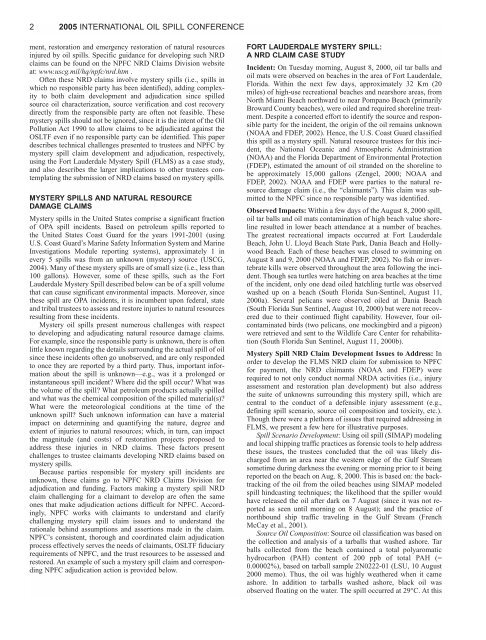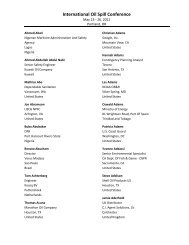adjudicating mystery spills, a natural resource damage claims case ...
adjudicating mystery spills, a natural resource damage claims case ...
adjudicating mystery spills, a natural resource damage claims case ...
Create successful ePaper yourself
Turn your PDF publications into a flip-book with our unique Google optimized e-Paper software.
2 2005 INTERNATIONAL OIL SPILL CONFERENCE<br />
ment, restoration and emergency restoration of <strong>natural</strong> <strong>resource</strong>s<br />
injured by oil <strong>spills</strong>. Specific guidance for developing such NRD<br />
<strong>claims</strong> can be found on the NPFC NRD Claims Division website<br />
at: www.uscg.mil/hq/npfc/nrd.htm .<br />
Often these NRD <strong>claims</strong> involve <strong>mystery</strong> <strong>spills</strong> (i.e., <strong>spills</strong> in<br />
which no responsible party has been identified), adding complexity<br />
to both claim development and adjudication since spilled<br />
source oil characterization, source verification and cost recovery<br />
directly from the responsible party are often not feasible. These<br />
<strong>mystery</strong> <strong>spills</strong> should not be ignored, since it is the intent of the Oil<br />
Pollution Act 1990 to allow <strong>claims</strong> to be adjudicated against the<br />
OSLTF even if no responsible party can be identified. This paper<br />
describes technical challenges presented to trustees and NPFC by<br />
<strong>mystery</strong> spill claim development and adjudication, respectively,<br />
using the Fort Lauderdale Mystery Spill (FLMS) as a <strong>case</strong> study,<br />
and also describes the larger implications to other trustees contemplating<br />
the submission of NRD <strong>claims</strong> based on <strong>mystery</strong> <strong>spills</strong>.<br />
MYSTERY SPILLS AND NATURAL RESOURCE<br />
DAMAGE CLAIMS<br />
Mystery <strong>spills</strong> in the United States comprise a significant fraction<br />
of OPA spill incidents. Based on petroleum <strong>spills</strong> reported to<br />
the United States Coast Guard for the years 1991-2001 (using<br />
U.S. Coast Guard’s Marine Safety Information System and Marine<br />
Investigations Module reporting systems), approximately 1 in<br />
every 5 <strong>spills</strong> was from an unknown (<strong>mystery</strong>) source (USCG,<br />
2004). Many of these <strong>mystery</strong> <strong>spills</strong> are of small size (i.e., less than<br />
100 gallons). However, some of these <strong>spills</strong>, such as the Fort<br />
Lauderdale Mystery Spill described below can be of a spill volume<br />
that can cause significant environmental impacts. Moreover, since<br />
these spill are OPA incidents, it is incumbent upon federal, state<br />
and tribal trustees to assess and restore injuries to <strong>natural</strong> <strong>resource</strong>s<br />
resulting from these incidents.<br />
Mystery oil <strong>spills</strong> present numerous challenges with respect<br />
to developing and <strong>adjudicating</strong> <strong>natural</strong> <strong>resource</strong> <strong>damage</strong> <strong>claims</strong>.<br />
For example, since the responsible party is unknown, there is often<br />
little known regarding the details surrounding the actual spill of oil<br />
since these incidents often go unobserved, and are only responded<br />
to once they are reported by a third party. Thus, important information<br />
about the spill is unknown—e.g., was it a prolonged or<br />
instantaneous spill incident? Where did the spill occur? What was<br />
the volume of the spill? What petroleum products actually spilled<br />
and what was the chemical composition of the spilled material(s)?<br />
What were the meteorological conditions at the time of the<br />
unknown spill? Such unknown information can have a material<br />
impact on determining and quantifying the nature, degree and<br />
extent of injuries to <strong>natural</strong> <strong>resource</strong>s; which, in turn, can impact<br />
the magnitude (and costs) of restoration projects proposed to<br />
address these injuries in NRD <strong>claims</strong>. These factors present<br />
challenges to trustee claimants developing NRD <strong>claims</strong> based on<br />
<strong>mystery</strong> <strong>spills</strong>.<br />
Because parties responsible for <strong>mystery</strong> spill incidents are<br />
unknown, these <strong>claims</strong> go to NPFC NRD Claims Division for<br />
adjudication and funding. Factors making a <strong>mystery</strong> spill NRD<br />
claim challenging for a claimant to develop are often the same<br />
ones that make adjudication actions difficult for NPFC. Accordingly,<br />
NPFC works with claimants to understand and clarify<br />
challenging <strong>mystery</strong> spill claim issues and to understand the<br />
rationale behind assumptions and assertions made in the claim.<br />
NPFC’s consistent, thorough and coordinated claim adjudication<br />
process effectively serves the needs of claimants, OSLTF fiduciary<br />
requirements of NPFC, and the trust <strong>resource</strong>s to be assessed and<br />
restored. An example of such a <strong>mystery</strong> spill claim and corresponding<br />
NPFC adjudication action is provided below.<br />
FORT LAUDERDALE MYSTERY SPILL:<br />
A NRD CLAIM CASE STUDY<br />
Incident: On Tuesday morning, August 8, 2000, oil tar balls and<br />
oil mats were observed on beaches in the area of Fort Lauderdale,<br />
Florida. Within the next few days, approximately 32 Km (20<br />
miles) of high-use recreational beaches and nearshore areas, from<br />
North Miami Beach northward to near Pompano Beach (primarily<br />
Broward County beaches), were oiled and required shoreline treatment.<br />
Despite a concerted effort to identify the source and responsible<br />
party for the incident, the origin of the oil remains unknown<br />
(NOAA and FDEP, 2002). Hence, the U.S. Coast Guard classified<br />
this spill as a <strong>mystery</strong> spill. Natural <strong>resource</strong> trustees for this incident,<br />
the National Oceanic and Atmospheric Administration<br />
(NOAA) and the Florida Department of Environmental Protection<br />
(FDEP), estimated the amount of oil stranded on the shoreline to<br />
be approximately 15,000 gallons (Zengel, 2000; NOAA and<br />
FDEP, 2002). NOAA and FDEP were parties to the <strong>natural</strong> <strong>resource</strong><br />
<strong>damage</strong> claim (i.e., the “claimants”). This claim was submitted<br />
to the NPFC since no responsible party was identified.<br />
Observed Impacts: Within a few days of the August 8, 2000 spill,<br />
oil tar balls and oil mats contamination of high beach value shoreline<br />
resulted in lower beach attendance at a number of beaches.<br />
The greatest recreational impacts occurred at Fort Lauderdale<br />
Beach, John U. Lloyd Beach State Park, Dania Beach and Hollywood<br />
Beach. Each of these beaches was closed to swimming on<br />
August 8 and 9, 2000 (NOAA and FDEP, 2002). No fish or invertebrate<br />
kills were observed throughout the area following the incident.<br />
Though sea turtles were hatching on area beaches at the time<br />
of the incident, only one dead oiled hatchling turtle was observed<br />
washed up on a beach (South Florida Sun-Sentinel, August 11,<br />
2000a). Several pelicans were observed oiled at Dania Beach<br />
(South Florida Sun Sentinel, August 10, 2000) but were not recovered<br />
due to their continued flight capability. However, four oilcontaminated<br />
birds (two pelicans, one mockingbird and a pigeon)<br />
were retrieved and sent to the Wildlife Care Center for rehabilitation<br />
(South Florida Sun Sentinel, August 11, 2000b).<br />
Mystery Spill NRD Claim Development Issues to Address: In<br />
order to develop the FLMS NRD claim for submission to NPFC<br />
for payment, the NRD claimants (NOAA and FDEP) were<br />
required to not only conduct normal NRDA activities (i.e., injury<br />
assessment and restoration plan development) but also address<br />
the suite of unknowns surrounding this <strong>mystery</strong> spill, which are<br />
central to the conduct of a defensible injury assessment (e.g.,<br />
defining spill scenario, source oil composition and toxicity, etc.).<br />
Though there were a plethora of issues that required addressing in<br />
FLMS, we present a few here for illustrative purposes.<br />
Spill Scenario Development: Using oil spill (SIMAP) modeling<br />
and local shipping traffic practices as forensic tools to help address<br />
these issues, the trustees concluded that the oil was likely discharged<br />
from an area near the western edge of the Gulf Stream<br />
sometime during darkness the evening or morning prior to it being<br />
reported on the beach on Aug. 8, 2000. This is based on: the backtracking<br />
of the oil from the oiled beaches using SIMAP modeled<br />
spill hindcasting techniques; the likelihood that the spiller would<br />
have released the oil after dark on 7 August (since it was not reported<br />
as seen until morning on 8 August); and the practice of<br />
northbound ship traffic traveling in the Gulf Stream (French<br />
McCay et al., 2001).<br />
Source Oil Composition: Source oil classification was based on<br />
the collection and analysis of a tarballs that washed ashore. Tar<br />
balls collected from the beach contained a total polyaromatic<br />
hydrocarbon (PAH) content of 200 ppb of total PAH (=<br />
0.00002%), based on tarball sample 2N0222-01 (LSU, 10 August<br />
2000 memo). Thus, the oil was highly weathered when it came<br />
ashore. In addition to tarballs washed ashore, black oil was<br />
observed floating on the water. The spill occurred at 29°C. At this



